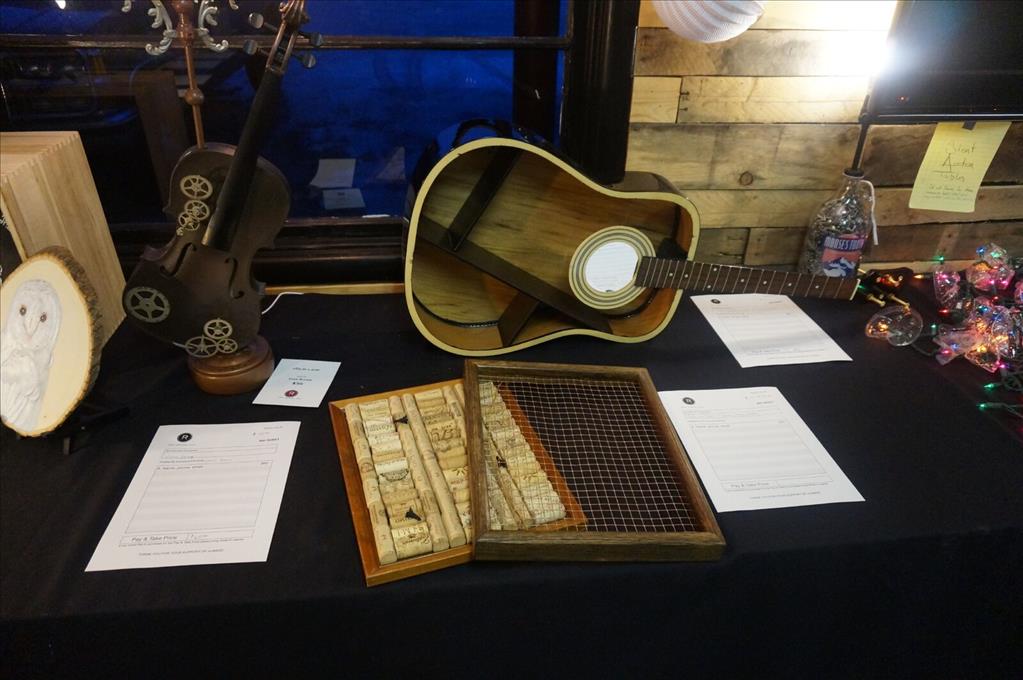UAA DNP alumna: 'Vivitrol's the path to an opioid-free life...it gets you clean'
by Tracy Kalytiak |
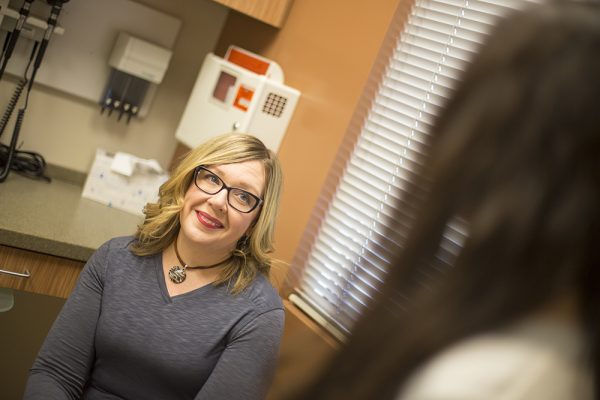
Christa, right, talks with UAA DNP alumna Jyll Green, left, at myHealth Clinic before receiving an injection of Vivitrol. Green's DNP project studied the effectiveness of Vivitrol shots among released prisoners. The injection Christa received Tuesday was her fourth since leaving jail. (Photo by Theodore Kincaid / University of Alaska Anchorage)
Christa never imagined she could become a heroin addict. She started drinking at high school parties and smoked marijuana for the first time when she was 14, calming anxiety she felt in social situations.
"I have a hard time being in crowds, and high school is the epitome of it," she said. "You're surrounded by people; it's an awkward time."
Christa didn't comprehend addiction, then. She just wanted to experiment.
"See what this felt like, see what that felt like, have fun and then be done and move on with my life, be successful, put all this behind me," she said. "Then I reached that point where I was like, 'OK, this isn't so fun anymore, this isn't causing anything good in my life, I think I'm ready to stop,' and I couldn't. It was a huge shock to me-I feel like I'm smart, I'm well educated, I have a great family, such strong will, I know better, I don't want to anymore. And I just couldn't stop."
A long, deep dive
Christa started shooting heroin in 2007, ending eight months of sobriety she'd earned after a stay in a California treatment program.
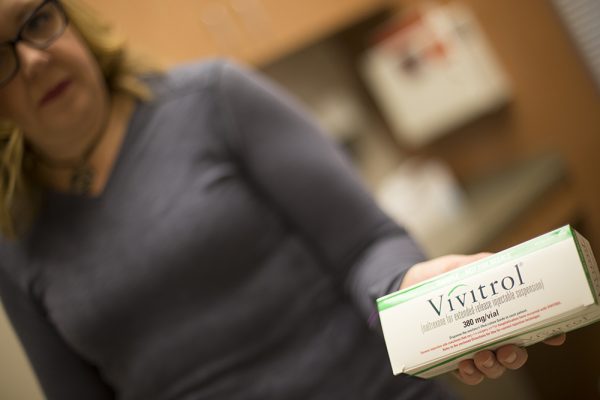
UAA DNP alumna Jyll Green holds a box containing Vivitrol. (Photo by Theodore Kincaid / University of Alaska Anchorage)
"It was me making the call to my friend, but I'd already made the decision in my mind that was what I was going to do," she said. "I'd already done injections before with meth when I'd gone to college in Reno, so I had no problem doing that with heroin."
Heroin felt like an overwhelming soft wave, immersing her in peace and calm.
"Like all your problems are going away mentally, like a complete relaxation," Christa said. "You don't have anything to worry about. You physically feel good. Especially here in Alaska, it makes you warm, physically warm. The anxiety, the constant thoughts of what I should be doing, this and that, it makes your mind just escape from all that. But ultimately it's just a mirage. Blocking your problems out doesn't make them go away."
California was where Christa was first arrested, for drug possession, a charge that ended with her doing her probation in Alaska and staying clean long enough to earn her college degree and find a Slope job.
Her sobriety ended shortly after she wrapped up her three years' probation.
"I started slipping again because I wasn't being monitored, no one was checking up on me anymore," she said.
One incident ended in a DUI conviction that made her a felon. More arrests followed, mostly for violating probation.
"I have friends who are dying on a regular basis from drug-related situations," Christa said. Two men with guns once broke into her home to steal drugs and money. They shot her boyfriend twice; Christa was able to escape out a back window.
That incident earned Christa her first probation violation, with 60 days at Hiland Mountain.
She got out-and returned to serve 90 days in jail two weeks later after violating probation by going to see her boyfriend while he was recovering from severe gunshot wounds. After being released, she stayed clean for four months.
"It just felt like nothing was going right," she said. "I was trying to get my life back on track but it was such a struggle to stay clean every day. I wasn't ready to get sober again after the shooting. I thought, the next time I go in, I'm going to really try and do things different and try to get sober."
Christa was serving time for another probation violation when she first heard about a drug called Vivitrol.
"I was willing to do anything," she said. "I'd been hearing about it for a while and thought it might help but I had no idea it was going to be as life-changing as it was. The second I got it, I made completely different decisions than I would have before, a complete 180. It was that drastic for me."
Vivitrol: 'It can be a lifestyle'

Jyll Green owns myHealth Clinic in South Anchorage. She recently earned her Doctor of Nursing Practice degree from UAA. Her DNP project researched recidivism rates among released inmates treated with monthly injections of Vivitrol. (Photo by Philip Hall / University of Alaska Anchorage)
Addiction to heroin and other opioids is a full-fledged epidemic throughout the United States; Alaska ranks in the nation's top 10 for opioid abuse.
Vivitrol first emerged back in 2006, used for treating alcoholism. Then, in 2010, Vivitrol-a "pure opioid antagonist" also known as naltrexone-was approved for use in people addicted to heroin and other opioid drugs. It provides a way to get off heroin without the need for other addictive opioids like methadone or suboxone.
"It can be a lifestyle," said Jyll Green, a family nurse practitioner who owns myHealth Clinic in South Anchorage; Green just received her Doctor of Nursing Practice at UAA, where she researched the effects of implementing Vivitrol in the recently released prisoner population. "It's a safety net. It also calms the brain down."
Heroin locks into tiny proteins on nerve cells called mu, kappa and delta receptors, producing a reaction that mimics the effects of a naturally occurring nervous system chemical called dopamine, producing intense feelings of euphoria and relaxation. An injection of Vivitrol given to someone who's been opioid-free for seven to 10 days (longer if methadone or buprenorphine have been used) will saturate all of the brain's opioid receptor sites and make it impossible for the person to get high for 28 to 32 days- even if a person uses heroin in that time, that shot will not have any effect.
"Then people don't just think, 'I have to use opioids, I have to use, where can I get some heroin, who's got some heroin, what can I do to get some heroin, I need money to buy heroin, can I call up so and so and go meet with them and use heroin,'" Green said. "If their opioid receptor sites are saturated, they don't crave. Within three hours of getting the shot, everyone says, 'I can run into my dealer and I'm OK, I don't feel the need to do heroin.' And they can't get high. A few people have tried it but they can't overcome that blockade and so they get nothing out of it."
Green's DNP project-done in collaboration with Partners for Progress Reentry Center-researched whether Vivitrol injections given monthly to opioid addicts released from prison would keep them from relapsing and being sent back behind bars.
"Most people have a vision of what they'd rather be," she said. "Being an addict is not anything people want to throw on their résumé.
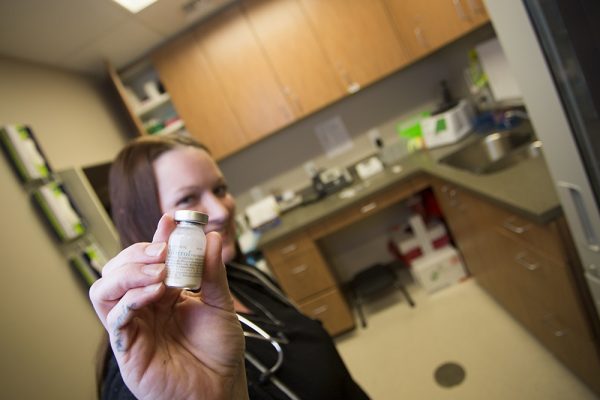
Sandi Johnson, medical assistant at UAA DNP alumna Jyll Green's South Anchorage practice, myHealth Clinic, shows a vial of Vivitrol. Monthly shots of the non-opioid drug prevent opioid addicts from getting high. (Photo by Theodore Kincaid / University of Alaska Anchorage)
Her study's findings indicated the Vivitrol injections worked: 62 percent of the freed inmates stayed clean. The 38 percent who ended up back in prison often went for reasons unrelated to drug use, like technical violations of their probation. "It wasn't necessarily because they were using," Green said.
A downside of Vivitrol is its expense. The cash price for one injection is approximately $1,200. One upside: Its manufacturer, Alkermes, has a $500 rebate card, bringing down the cash price to $700 per shot. Another big upside: released inmates and others addicted to opioids often qualify for Medicaid, which will pay for the injection.
Green says obstacles are that many people don't know about Vivitrol and how effective it is, and don't realize that treatment with methadone or suboxone merely switches addicts to other opioids rather than turning off their desire for any opioid. Vivitrol should be supplemented, Green said, with therapy that addresses and treats the issues-anxiety or trauma, for example-that may have contributed to drug use in the first place.
Her study succeeded, Green said, in part because the Alaska community is small, a place where it's easy to create connections to solve problems.
"We should be able to make better connections with all of our community partners to treat this," Green said.
Addiction is a complex problem that requires different solutions for different people.
"You've got to have a provider who's willing to prescribe [Vivitrol] to treat this, to get them off the opioids," she said. "And we really need to back that up with appropriate behavioral health [care] so they can learn some new coping skills."
Vivitrol might provide help on a larger scale-offering a new prevention-oriented way to address budget woes associated with the raging epidemic of opioid use in Alaska.
More than 78 percent of the people incarcerated in Alaska right now self-identify as having a history of substance or alcohol abuse. "That means the [Alaska Department of Corrections] has now become the largest behavioral health provider in the state," she said. "And they know that. In a year, they'll treat about 500 people."
The cost of incarcerating someone in Alaska is about $158 a day, a figure that does not include court costs, district attorney and judges' fees and other costs outside incarceration.
"It's just the hard-bed costs in jail or prison," Green said. "Our prisons are saturated, the walls are bursting. We don't need another prison. At $158 a day, it's expensive to incarcerate people because they have substance abuse. If that 78 percent didn't have substance abuse, they would never need to go to prison."
'These are not bad people'
Providers sometimes shy away from offering services to addicts.
Green said she was going to talk to the Alaska Nurse Practitioners Conference this year and someone said to her, "Aren't you afraid of having these people in your office?"
"I said, 'What people? You mean the patients who have addiction?'" Green recounted. "They said, 'Well, yeah, you've got such a nice office, why would you want those people running around in your office? Isn't that bringing trouble?' And I said, 'We're actually getting people off opioids, not on.' It's not like people are going to flood the gates for those shots of Vivitrol."
Green says addicts usually want help.
"For the most part, I don't meet addicts that want to be addicted," she said. "It's not a choice, it's a disease state. These are not bad people; these are good people with a bad disease who need an opportunity to be well."
'I think it would make a huge difference'
Christa applied for Medicaid while at Hiland Mountain Correctional Center and emerged from jail Oct. 27. As soon as she was out, she connected with Partners Reentry Center, which sent her to Green's office, one of the three places in Anchorage that provide Vivitrol injections (the others are the Alaska Native Medical Center and Anchorage Neighborhood Health Center).
"When I was in jail, I heard of Partners for Progress and other people telling me you can get out of jail and they will give it to you right there," she said. "I found out I needed to get out of jail myself and physically go into the [Partners Reentry Center] office and tell them I want it and then they will get me to the clinic to get it. So it was up to me to get there and do that."
That gap, she said, could present trouble for someone who's an addict.
"That ride from [Partners] to the place to get [the Vivitrol injection], you can make a lot of bad decisions in that time," Christa said. "Even just my day out, if I hadn't gone and got that shot when I did, things would be drastically different for me right now."
Ideally, Christa said, someone would give the first Vivitrol injection right there in the jail.
"The faster and easier you can get it, to where you don't have that time to change your mind," she said. "Because I've seen people walk out of the doors of the jail with a ride on their way that's coming, that's safe, and they'll change their mind in a split second and take a cab and be gone. It's that fast. A doctor waiting outside the doors...I think it would make a huge difference."
Vivitrol might not make the difference to someone who is still determined to use, but for Christa-an addicted person who was wanting to change her life-it was a lifeline.
"All I can speak for is my experience, but it's nothing but positive things," Christa said. "It's completely changed my life, made my life possible again. I know I'm not the only one that would have this reaction. Why not give it a chance?"
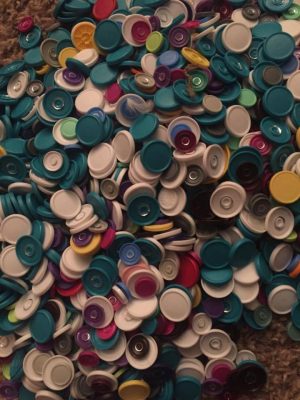
This picture shows vial caps from UAA DNP alumna Jyll Green's business in South Anchorage, myHealth Clinic. The teal-blue caps are from vials of Vivitrol. (Photo by Sandi Johnson)
'Every blue cap is a life'
Green's medical assistant, Sandi Johnson, saves all the vial caps from vaccines and other medications the clinic administers-"You can go on Pinterest and look at vial cap art; people make beautiful pictures," Green said.
One day, a staff member emptied all those vial caps on the carpet at the clinic. All the teal-blue caps were from vials of Vivitrol.
"It was like this sea of blue with some white and a few other colors mixed in from the vaccines we give," Green said. "But it was predominantly blue. Thousands of caps, mostly blue. Sandi said every blue cap is a life. That was pretty phenomenal."
Written by Tracy Kalytiak, University of Alaska Anchorage
 "UAA DNP alumna: 'Vivitrol's the path to an opioid-free life...it gets you clean'" is licensed under a Creative Commons Attribution-NonCommercial 4.0 International License.
"UAA DNP alumna: 'Vivitrol's the path to an opioid-free life...it gets you clean'" is licensed under a Creative Commons Attribution-NonCommercial 4.0 International License.











